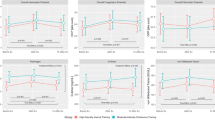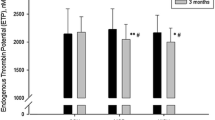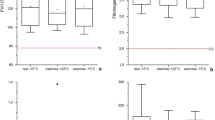Abstract
Randomized controlled trials (RCTs) on the topic of physical training and blood coagulation are rare and the effects are unclear. The aim of this study was to investigate whether endurance training adjusts blood coagulation and fibrinolysis at rest and after exercise. The study included 50 healthy untrained non-smokers randomized into training (TR 49 ± 6 years) or control group (CO 48 ± 6 years). Each subject performed an exercise test adjusted at 80 % individual anaerobic threshold (IAT) for 60 min before and after 12 weeks (80 % IAT: before TR 123 ± 20, CO 125 ± 26 W; after TR 148 ± 23 W, CO 127 ± 25 W; mean ± SD). Blood was taken at rest and after exercise to determine coagulation (e.g., aPTT, thrombin potential, TAT, F1+2, several coagulation factors) and fibrinolytic (e.g., tPA, PAI) parameters. The training intervention induced an elevation of physical capacity in TR by 17 % (rel. VO2max) that led to a statistical relevant prolongation of aPTT at rest. Although absolute power output during the second exercise test was 20 % higher in TR, we detected an attenuated exercise-induced decrease of aPTT and attenuated increase of F1+2 after training. Resting levels of tPA- and PAI-Ag decreased slightly but not significantly after training. Exercise-induced changes were comparable after training in spite of higher power output in TR. Although the effects are small in healthy men, training modifies exercise-induced blood coagulation positively. The fact that exercise-induced changes in blood coagulation and fibrinolysis are rather attenuated or unchanged in the training group, in spite of a 20 % higher absolute power output during exercise, substantiates the adjusting effect of endurance training and the importance of physical fitness in primary prevention.
Similar content being viewed by others
References
Bodary PF, Yasuda N, Watson DD, Brown AS, Davis JM, Pate RR (2003) Effects of short-term exercise training on plasminogen activator inhibitor (PAI-1). Med Sci Sports Exerc 35(11):1853–1858
Coppola L, Grassia A, Coppola A, Tondi G, Peluso G, Mordente S, Gombos G (2004) Effects of a moderate-intensity aerobic program on blood viscosity, platelet aggregation and fibrinolytic balance in young and middle-aged sedentary subjects. Blood Coagul Fibrinolysis 15(1):31–37
de Geus EJ, Kluft C, de Bart AC, van Doornen LJ (1992) Effects of exercise training on plasminogen activator inhibitor activity. Med Sci Sports Exerc 24(11):1210–1219
Dill DB, Costill DL (1974) Calculation of percentage changes in volumes of blood, plasma, and red cells in dehydration. J Appl Physiol 37(2):247–248
El-Sayed MS (1996) Effects of high and low intensity aerobic conditioning programs on blood fibrinolysis and lipid profile. Blood Coagul Fibrinolysis 7(4):484–490
El-Sayed MS, Lin X, Rattu AJ (1995) Blood coagulation and fibrinolysis at rest and in response to maximal exercise before and after a physical conditioning programme. Blood Coagul Fibrinolysis 6(8):747–752
El-Sayed MS, El-Sayed Ali Z, Ahmadizad S (2004) Exercise and training effects on blood haemostasis in health and disease: an update. Sports Med 34(3):181–200
Hemker HC, Beguin S (1995) Thrombin generation in plasma: its assessment via the endogenous thrombin potential. Thromb Haemost 74(1):134–138
Hemker HC, Wielders S, Kessels H, Beguin S (1993) Continuous registration of thrombin generation in plasma, its use for the determination of the thrombin potential. Thromb Haemost 70(4):617–624
Hilberg T, Prasa D, Stürzebecher J, Gläser D, Gabriel HH (2002) Thrombin potential and thrombin generation after exhaustive exercise. Int J Sports Med 23(7):500–504
Hilberg T, Gläser D, Reckhart C, Prasa D, Stürzebecher J, Gabriel HH (2003a) Blood coagulation and fibrinolysis after long-duration treadmill exercise controlled by individual anaerobic threshold. Eur J Appl Physiol 90(5–6):639–642
Hilberg T, Prasa D, Stürzebecher J, Gläser D, Schneider K, Gabriel HH (2003b) Blood coagulation and fibrinolysis after extreme short-term exercise. Thromb Res 109(5–6):271–277
Jahangard T, Torkaman G, Ghoosheh B, Hedayati M, Dibaj A (2009) The effect of short-term aerobic training on coagulation and fibrinolytic factors in sedentary healthy postmenopausal women. Maturitas 64(4):223–227
Khaw KT, Woodhouse P (1995) Interrelation of vitamin C, infection, haemostatic factors, and cardiovascular disease. BMJ 310(6994):1559–1563
Lee IM, Paffenbarger RS Jr (1998) Physical activity and stroke incidence: the Harvard Alumni Health Study. Stroke 29(10):2049–2054
Leon AS, Connett J (1991) Physical activity and 10.5 year mortality in the Multiple Risk Factor Intervention Trial (MRFIT). Int J Epidemiol 20(3):690–697
Lockard MM, Gopinathannair R, Paton CM, Phares DA, Hagberg JM (2007) Exercise training-induced changes in coagulation factors in older adults. Med Sci Sports Exerc 39(4):587–592
Mavri A, Guzic-Salobir B, Salobir-Pajnic B, Keber I, Stare J, Stegnar M (2001) Seasonal variation of some metabolic and haemostatic risk factors in subjects with and without coronary artery disease. Blood Coagul Fibrinolysis 12(5):359–365
Menzel K, Hilberg T (2009) Coagulation and fibrinolysis are in balance after moderate exercise in middle-aged participants. Clin Appl Thromb Hemost 15(3):348–355
Menzel K, Hilberg T (2011) Blood coagulation and fibrinolysis in healthy, untrained subjects: effects of different exercise intensities controlled by individual anaerobic threshold. Eur J Appl Physiol 111(2):253–260
Prasa D, Svendsen L, Stürzebecher J (1997a) The ability of thrombin inhibitors to reduce the thrombin activity generated in plasma on extrinsic and intrinsic activation. Thromb Haemost 77(3):498–503
Prasa D, Svendsen L, Stürzebecher J (1997b) Inhibition of thrombin generation in plasma by inhibitors of factor Xa. Thromb Haemost 78(4):1215–1220
Rudez G, Meijer P, Spronk HM, Leebeek FW, ten Cate H, Kluft C, de Maat MP (2009) Biological variation in inflammatory and hemostatic markers. J Thromb Haemost 7(8):1247–1255
Schulz KF, Grimes DA (2002) Generation of allocation sequences in randomised trials: chance, not choice. Lancet 359(9305):515–519
Shaper AG, Wannamethee G, Weatherall R (1991) Physical activity and ischaemic heart disease in middle-aged British men. Br Heart J 66(5):384–394
Stratton JR, Chandler WL, Schwartz RS, Cerqueira MD, Levy WC, Kahn SE, Larson VG, Cain KC, Beard JC, Abrass IB (1991) Effects of physical conditioning on fibrinolytic variables and fibrinogen in young and old healthy adults. Circulation 83(5):1692–1697
Sugawara J, Hayashi K, Kurachi S, Tanaka T, Yokoi T, Kurachi K (2008) Age-related effects of regular physical activity on hemostatic factors in men. J Thromb Thrombolysis 26(3):203–210
Suzuki T, Yamauchi K, Yamada Y, Furumichi T, Furui H, Tsuzuki J, Hayashi H, Sotobata I, Saito H (1992) Blood coagulability and fibrinolytic activity before and after physical training during the recovery phase of acute myocardial infarction. Clin Cardiol 15(5):358–364
van den Burg PJ, Hospers JE, van Vliet M, Mosterd WL, Bouma BN, Huisveld IA (1997) Effect of endurance training and seasonal fluctuation on coagulation and fibrinolysis in young sedentary men. J Appl Physiol 82(2):613–620
Wang JS (2006) Exercise prescription and thrombogenesis. J Biomed Sci 13(6):753–761
Woodhouse PR, Khaw KT, Plummer M, Foley A, Meade TW (1994) Seasonal variations of plasma fibrinogen and factor VII activity in the elderly: winter infections and death from cardiovascular disease. Lancet 343(8895):435–439
Acknowledgments
The authors would like to thank Prof. H. Gabriel and Mrs. B. Dorschner from the Department of Sports Medicine at the Friedrich-Schiller-University Jena for their kind support; Dr. W. Ackermann for the assessment of several coagulation factor activities; Dr. L. Wagner Technoclone GmbH Vienna Austria as well as Dr. E. Kunzmann and Mr. T. Noll formerly Dade Behring GmbH for their kind support with ELISA kits. In addition, the authors thank Mrs. E. Wangari for her linguistic input.
Author information
Authors and Affiliations
Corresponding author
Additional information
Communicated by David C. Poole.
Rights and permissions
About this article
Cite this article
Hilberg, T., Menzel, K. & Wehmeier, U.F. Endurance training modifies exercise-induced activation of blood coagulation: RCT. Eur J Appl Physiol 113, 1423–1430 (2013). https://doi.org/10.1007/s00421-012-2564-9
Received:
Accepted:
Published:
Issue Date:
DOI: https://doi.org/10.1007/s00421-012-2564-9




